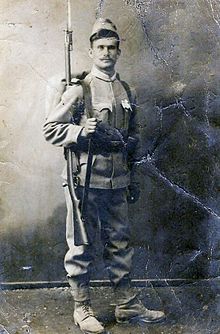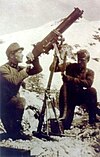Mannlicher M1888
This article has multiple issues. Please help improve it or discuss these issues on the talk page. (Learn how and when to remove these messages)
|
The Repeating Rifle Mannlicher 1888 better known as Mannlicher M1888 was a bolt-action rifle used by several armies from 1888 to 1945. Derived from the M1885 and later M1886 models, it was Ferdinand Mannlicher's third rifle that utilized the "enbloc clip".
It was succeeded by the Mannlicher M1895 as the standard service rifle of the Austro-Hungarian Army. The M95 uses a more secure rotating-bolt, in contrast to the M88's wedge-lock bolt.
History

The M1888 was a direct and immediate descendant of the M1886 Austrian Mannlicher. This rifle too was a straight-pull, bolt-action, box magazine repeater. As early as the beginning of production of the M1886 the need and desirability for a small-bore rifle was evident. This rifle is virtually identical to its predecessor but for chambering a newly designed 8 mm cartridge, loaded originally with black powder and denominated 8×52mmR.

M1888-90 rifle
Shortly thereafter, the M88 cartridge was converted to semi-smokeless powder. The new cartridge was designated 8mm M.1890 scharfe Patrone and its dimensions were 8×50mmR. The sights of existing black powder 8mm Mannlicher rifles were converted to accommodate semi-smokeless ammunition by the functional arrangement of screw mounting re-graduated sideplates onto the outsides of the existing rear sight walls. The converted rifles were denominated M.88–90.
M1890 rifle
When in 1890 semi-smokeless powder became available, manufacture of rifles with a longer and thus stronger chamber and modified sights began. Although the smokeless powder filled M.93 8×50mmR cartridge can be used in this rifle, the generated pressure at 40,000 psi (275.8 MPa) is marginal, as the wedge-lock bolt system this rifle uses was originally designed to be shot with less potent black powder filled 11×58mmR ammunution.
Kuaili 1888 Kiangnan Rifle 7.62x55
China also used this rifle extensively during the Qing dynasty and the Republican era. China first bought Mannlicher 88 rifles before the First Sino-Japanese War in 1894–1895 and after that started production of the unlicensed Kuaili 1888 Kiangnan copy.[13][14]
Users
 Austria-Hungary
Austria-Hungary First Austrian Republic
First Austrian Republic Boers[15]
Boers[15] Kingdom of Bulgaria
Kingdom of Bulgaria China[16]
China[16] Republic of China (1912–28)[17]
Republic of China (1912–28)[17] Chile[18]
Chile[18] Czechoslovakia
Czechoslovakia Sudeten German Party
Sudeten German Party Ecuador[19]
Ecuador[19] Ethiopian Empire[6]
Ethiopian Empire[6] Nazi Germany: Used by Volkssturm.[20]
Nazi Germany: Used by Volkssturm.[20] Kingdom of Greece: Captured from Bulgaria during the Second Balkan War and at the end of World War I.[5][10]
Kingdom of Greece: Captured from Bulgaria during the Second Balkan War and at the end of World War I.[5][10] Haganah[citation needed]
Haganah[citation needed] Kingdom of Hungary
Kingdom of Hungary India[6][21]
India[6][21] Kingdom of Italy[6][1][22]
Kingdom of Italy[6][1][22] Persia
Persia Philippines[2]
Philippines[2] Second Polish Republic
Second Polish Republic Kingdom of Romania: Before Second Balkan War Romania bought circa 60.000 Mannlicher M.90 and M.95.[23]
Kingdom of Romania: Before Second Balkan War Romania bought circa 60.000 Mannlicher M.90 and M.95.[23] Russian Empire
Russian Empire Soviet Russia
Soviet Russia Kingdom of Serbia[24]
Kingdom of Serbia[24] Kingdom of Siam : According to Steyr sales records, 15,000 M1888 rifles were furnished to Siam, most in the 1890s. Some may have been used items, sold from Austrian military stocks.[25][26]
Kingdom of Siam : According to Steyr sales records, 15,000 M1888 rifles were furnished to Siam, most in the 1890s. Some may have been used items, sold from Austrian military stocks.[25][26] Spain
Spain Second Spanish Republic[27][28]
Second Spanish Republic[27][28] United Kingdom : Captured in Ethiopia, used by African or Indian troops in Garrison/Guard duties in Abyssinia in the 1941-42 period, and then ended up (along with all the rest of the captured Equipment) in India, the more modern rifles (M95s and Carcanos) and MGs, going to front line training ( Burma Front) and the rest (like M88) to straight training units and guard duty in the boonies of India.[6][29]
United Kingdom : Captured in Ethiopia, used by African or Indian troops in Garrison/Guard duties in Abyssinia in the 1941-42 period, and then ended up (along with all the rest of the captured Equipment) in India, the more modern rifles (M95s and Carcanos) and MGs, going to front line training ( Burma Front) and the rest (like M88) to straight training units and guard duty in the boonies of India.[6][29] Kingdom of Yugoslavia
Kingdom of Yugoslavia
References
- ^ a b "Fucile Mannlicher 1888". Euroarms.net. Retrieved 24 July 2018.
- ^ a b citation?
- ^ "Archived copy". Archived from the original on 27 September 2015. Retrieved 18 September 2015.
{{cite web}}: CS1 maint: archived copy as title (link) - ^ "Broń strzelecka polskiego wojska w wojnie polsko-bolszewickiej". ossow1920.pl.
- ^ a b "Weapons Of The Greco-Turkish War Part 1Guns Magazine.com - Guns Magazine.com". gunsmagazine.com. Archived from the original on 5 October 2015. Retrieved 18 September 2015.
- ^ a b c d e "M88/90 Mannlicher find. AOI and British?". forums.gunboards.com.[unreliable source?]
- ^ Nicolle, David (20 July 2012). The Italian Invasion of Abyssinia 1935–36. Bloomsbury Publishing. ISBN 9781782001324 – via Google Books.
- ^ Joseph, Frank (6 May 2010). Mussolini's War: Fascist Italy's Military Struggles from Africa and Western Europe to the Mediterranean and Soviet Union 1935-45. Helion and Company. ISBN 9781906033569 – via Google Books.
- ^ "Spanishcivilwar1".
- ^ a b "Part I of the greek civil war the first battles of the "cold war": partisan groups in Greece were as eager or more to fight each other as the Germans. Even before the Nazis were gone, civil war was underway. - Free Online Library". www.thefreelibrary.com.
- ^ [1] Archived 17 October 2017 at the Wayback Machine
- ^ "Вход". gunbg.com.
- ^ "Archived copy". Archived from the original on 27 March 2015. Retrieved 31 May 2017.
{{cite web}}: CS1 maint: archived copy as title (link) - ^ "Info" (PDF). www.mh.sinica.edu.tw.
- ^ "6 Rifles Used by the Afrikaners During the Second Boer War". 17 April 2017.
- ^ "Antique 1886 Austrian Chinese Marked". www.aagaines.com.
- ^ Philip S. Jowett (2010). Chinese Warlord Armies, 1911–30. Osprey Publishing. pp. 43–. ISBN 978-1-84908-402-4.
- ^ John Walter (25 March 2006). Rifles of the World. Krause Publications. pp. 263–271. ISBN 0-89689-241-7. Retrieved 8 September 2014.
- ^ Robert W.D. Ball (2 August 2011). Mauser Military Rifles of the World. Gun Digest Books. p. 127. ISBN 978-1-4402-1544-5.
- ^ "Small arms of the Deutscher Volkssturm part I: Nazi leaders, many of whom already had their tickets punched for Argentina, preached last-ditch resistance to the German people, and provided a motley assortment of tools for the purpose. - Free Online Library". www.thefreelibrary.com.
- ^ "Mannlicher 88/90 stock markings".[unreliable source?]
- ^ "Italian Mannlicher M95 Rifle and Carbine".
- ^ Philip Jowett (20 March 2012). Armies of the Balkan Wars 1912-13: The priming charge for the Great War. Osprey Publishing. p. 24. ISBN 978-1-78096-528-4.
- ^ "Tribute to Michael Kreca: The Rifles of Yugoslavia and Serbia". tributetomichaelkreca.blogspot.cz.
- ^ "Bayonets of Siam (Thailand)". worldbayonets.com.
- ^ Scarlata, Paul (September 2013). "Siamese Thai: Military Rifle cartridges". Shotgun News – via thefreelibrary.com.
- ^ de Quesada, Alejandro (20 January 2015). The Spanish Civil War 1936–39 (2): Republican Forces. Men-at-Arms 498. Osprey Publishing. p. 38. ISBN 9781782007852.
- ^ "Small arms of the Spanish Civil War" (PDF). www.forgottenweapons.com.
- ^ ""AOI"-marked Mannlicher M1888 and the Meaning of "St. 91"". forums.gunboards.com.[unreliable source?]
- "8 x 50 R Mannlicher - www.militaryrifles.com/Austria/88Mann.htm". militaryrifles.com. Archived from the original on 14 June 2012. Retrieved 22 November 2013.


